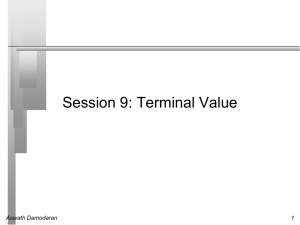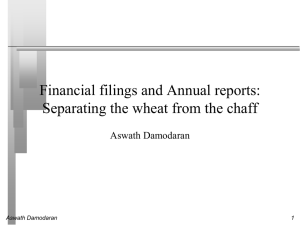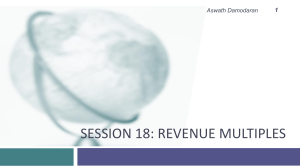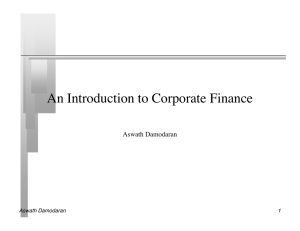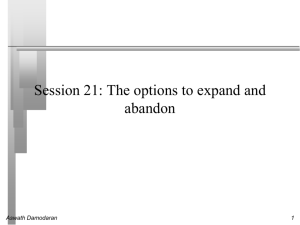closure in valuation - NYU Stern School of Business
advertisement
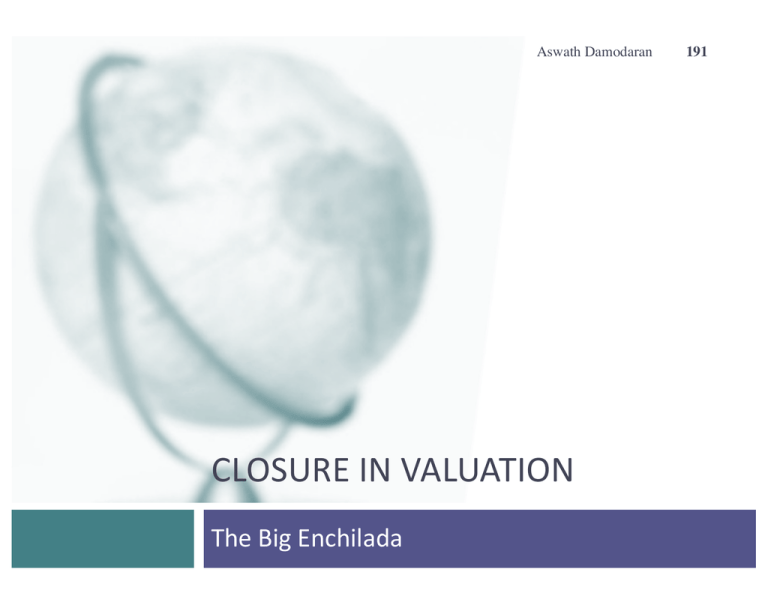
Aswath Damodaran CLOSUREINVALUATION TheBigEnchilada 191 GettingClosureinValuation 192 ¨ Apubliclytradedfirmpotentiallyhasaninfinitelife.Thevalueistherefore thepresentvalueofcashflowsforever. t=∞ CF t Value = ∑ t t=1 (1+r) ¨ Sincewecannotestimatecashflowsforever,weestimatecashflowsfora “growthperiod” andthenestimateaterminalvalue,tocapturethevalue attheendoftheperiod: t=N CF t + Terminal Value Value = ∑ N t (1+r) (1+r) t=1 Aswath Damodaran 192 WaysofEstimatingTerminalValue 193 Terminal Value Liquidation Value Most useful when assets are separable and marketable Aswath Damodaran Multiple Approach Easiest approach but makes the valuation a relative valuation Stable Growth Model Technically soundest, but requires that you make judgments about when the firm will grow at a stable rate which it can sustain forever, and the excess returns (if any) that it will earn during the period. 193 1.Obeythegrowthcap 194 ¨ Whenafirm’scashflowsgrowata“constant” rateforever,thepresent valueofthosecashflowscanbewrittenas: Value=ExpectedCashFlowNextPeriod/(r- g) where, r=Discountrate(CostofEquityorCostofCapital) g=Expectedgrowthrate ¨ Thestablegrowthratecannotexceedthegrowthrateoftheeconomybut itcanbesetlower. • • • ¨ Ifyouassumethattheeconomyiscomposedofhighgrowthandstablegrowthfirms, thegrowthrateofthelatterwillprobablybelowerthanthegrowthrateofthe economy. Thestablegrowthratecanbenegative.Theterminalvaluewillbelowerandyouare assumingthatyourfirmwilldisappearovertime. Ifyouusenominalcashflows anddiscountrates,thegrowthrateshouldbenominalin thecurrencyinwhichthevaluationisdenominated. Onesimpleproxyforthenominalgrowthrateoftheeconomyisthe riskfree rate. Aswath Damodaran 194 RiskfreeRatesandNominalGDPGrowth ¨ ¨ RiskfreeRate=ExpectedInflation+ ExpectedRealInterestRate Therealinterestrateiswhatborrowers agreetoreturntolendersinreal goods/services. ¨ ¨ NominalGDPGrowth=ExpectedInflation +ExpectedRealGrowth Therealgrowthrateintheeconomy measurestheexpectedgrowthinthe productionofgoodsandservices. The argument for Risk free rate = Nominal GDP growth 1. In the long term, the real growth rate cannot be lower than the real interest rate, since you have the growth in goods/services has to be enough to cover the promised rate. 2. In the long term, the real growth rate can be higher than the real interest rate, to compensate risk taking. However, as economies mature, the difference should get smaller and since there will be growth companies in the economy, it is prudent to assume that the extra growth comes from these companies. Period 1954-2015 1954-1980 1981-2008 2009-2015 10-YearT.Bond Rate 5.93% 5.83% 6.88% 2.57% InflationRate RealGDPGrowth 3.61% 3.06% 4.49% 3.50% 3.26% 3.04% 1.66% 1.47% NominalGDP growthrate 6.67% 7.98% 6.30% 3.14% NominalGDP- T.Bond Rate 0.74% 2.15% -0.58% 0.57% APracticalReasonforusingtheRiskfree RateCap– PreserveConsistency 196 ¨ ¨ You are implicitly making assumptions about nominal growth in the economy, with your risk free rate. Thus, with a low risk free rate, you are assuming low nominal growth in the economy (with low inflation and low real growth) and with a high risk free rate, a high nominal growth rate in the economy. If you make an explicit assumption about nominal growth in cash flows that is at odds with your implicit growth assumption in the denominator, you are being inconsistent and bias your valuations: ¤ ¤ If you assume high nominal growth in the economy, with a low risk free rate, you will over value businesses. If you assume low nominal growth rate in the economy, with a high risk free rate, you will under value businesses. Aswath Damodaran 196 2.Don’twaittoolong… 197 ¨ Assumethatyouarevaluingayoung,highgrowthfirmwith greatpotential,justafteritsinitialpublicoffering.Howlong wouldyousetyourhighgrowthperiod? a. b. c. d. ¨ <5years 5years 10years >10years Whileanalystsroutinelyassumeverylonghighgrowth periods(withsubstantialexcessreturnsduringtheperiods), theevidencesuggeststhattheyaremuchtoooptimistic. Mostgrowthfirmshavedifficultysustainingtheirgrowthfor longperiods,especiallywhileearningexcessreturns. Aswath Damodaran 197 Andtietocompetitiveadvantages 198 ¨ ¨ ¨ Recappingakeylessonaboutgrowth,itisnot growthpersethatcreatesvaluebutgrowthwith excessreturns.Forgrowthfirmstocontinueto generatevaluecreatinggrowth,theyhavetobeable tokeepthecompetitionatbay. Proposition1:Thestrongerandmoresustainable thecompetitiveadvantages,thelongeragrowth companycansustain“valuecreating”growth. Proposition2:Growthcompanieswithstrongand sustainablecompetitiveadvantagesarerare. Aswath Damodaran 198 3.Don’tforgetthatgrowthhastobeearned.. 199 ¨ Inthesectiononexpectedgrowth,welaidoutthefundamental equationforgrowth: Growthrate=ReinvestmentRate*Returnoninvestedcapital +Growthratefromimprovedefficiency ¨ ¨ Instablegrowth,youcannotcountonefficiencydeliveringgrowth andyouhavetoreinvesttodeliverthegrowthratethatyouhave forecast. Consequently,yourreinvestmentrateinstablegrowthwillbea functionofyourstablegrowthrateandwhatyoubelievethefirm willearnasareturnoncapitalinperpetuity: ¤ ¨ ReinvestmentRate=Stablegrowthrate/StableperiodROC=g/ROC Yourterminalvalueequationcanthenberewrittenas: TerminalValueinyearn = Aswath Damodaran ./01 234 567 (56 9 ) :;< (>?@7?A>BCD7BE6F) 199 TheBigAssumption 200 Growthrateforever Returnoncapitalinperpetuity 6% 8% 10% 12% 14% 0.0% $1,000 $1,000 $1,000 $1,000 $1,000 0.5% $965 $987 $1,000 $1,009 $1,015 1.0% $926 $972 $1,000 $1,019 $1,032 1.5% $882 $956 $1,000 $1,029 $1,050 2.0% $833 $938 $1,000 $1,042 $1,071 2.5% $778 $917 $1,000 $1,056 $1,095 3.0% $714 $893 $1,000 $1,071 $1,122 Terminal value for a firm with expected after-tax operating income of $100 million in year n+1 and a cost of capital of 10%. Aswath Damodaran 200 ExcessReturnstoZero? 201 ¨ ¨ Therearesome(McKinsey,forinstance)whoarguethatthereturnon capitalshouldalwaysbeequaltocostofcapitalinstablegrowth. Butexcessreturnsseemtopersistforverylongtimeperiods. Aswath Damodaran 201 Anddon’tfallforsleightofhand… 202 ¨ ¨ AtypicalassumptioninmanyDCFvaluations,whenit comestostablegrowth,isthatcapitalexpenditures offsetdepreciationandtherearenoworkingcapital needs.Stablegrowthfirms,wearetold,justhaveto makemaintenancecapex(replacingexistingassets)to delivergrowth.Ifyoumakethisassumption,what expectedgrowthratecanyouuseinyourterminalvalue computation? Whatifthestablegrowthrate=inflationrate?Isitokay tomakethisassumptionthen? Aswath Damodaran 202 4.Beinternallyconsistent 203 ¨ Riskandcostsofequityandcapital:Stablegrowthfirmstend to ¤ ¤ ¤ ¨ ¨ Havebetasclosertoone Havedebtratiosclosertoindustryaverages(ormaturecompany averages) Countryriskpremiums(especiallyinemergingmarketsshouldevolve overtime) Theexcessreturnsatstablegrowthfirmsshouldapproach(or become)zero.ROC->CostofcapitalandROE->Costof equity Thereinvestmentneedsanddividendpayoutratiosshould reflectthelowergrowthandexcessreturns: ¤ ¤ Stableperiodpayoutratio=1- g/ROE Stableperiodreinvestmentrate=g/ROC Aswath Damodaran 203


